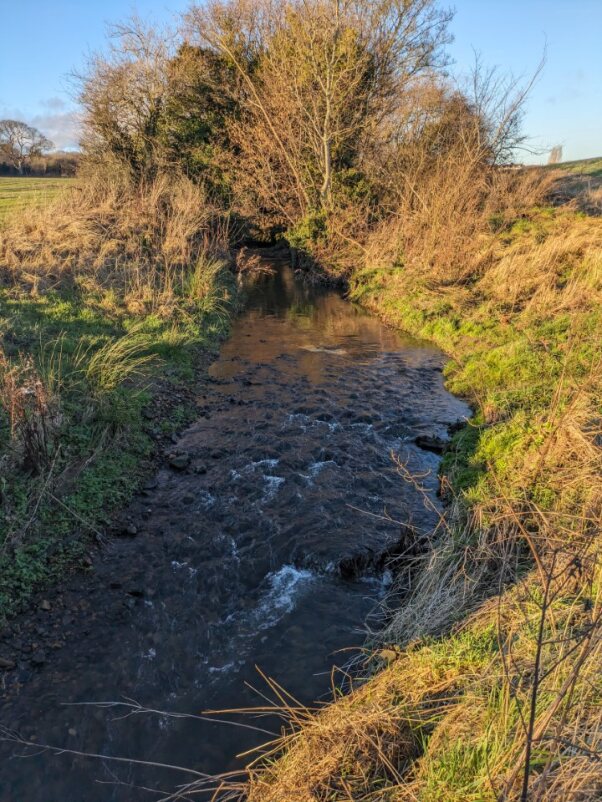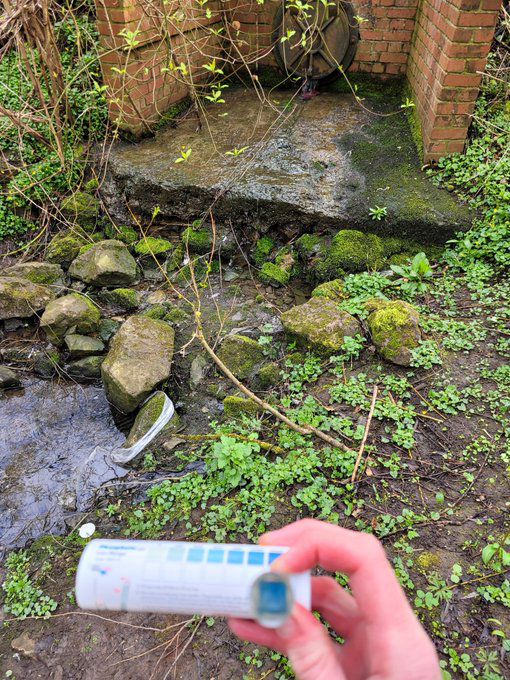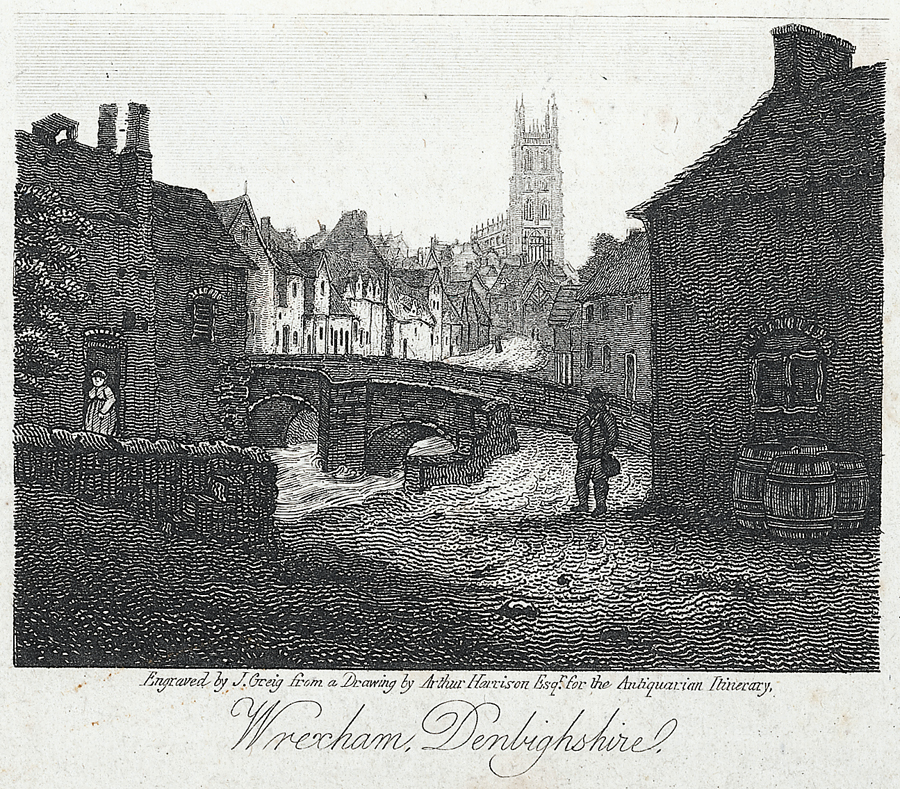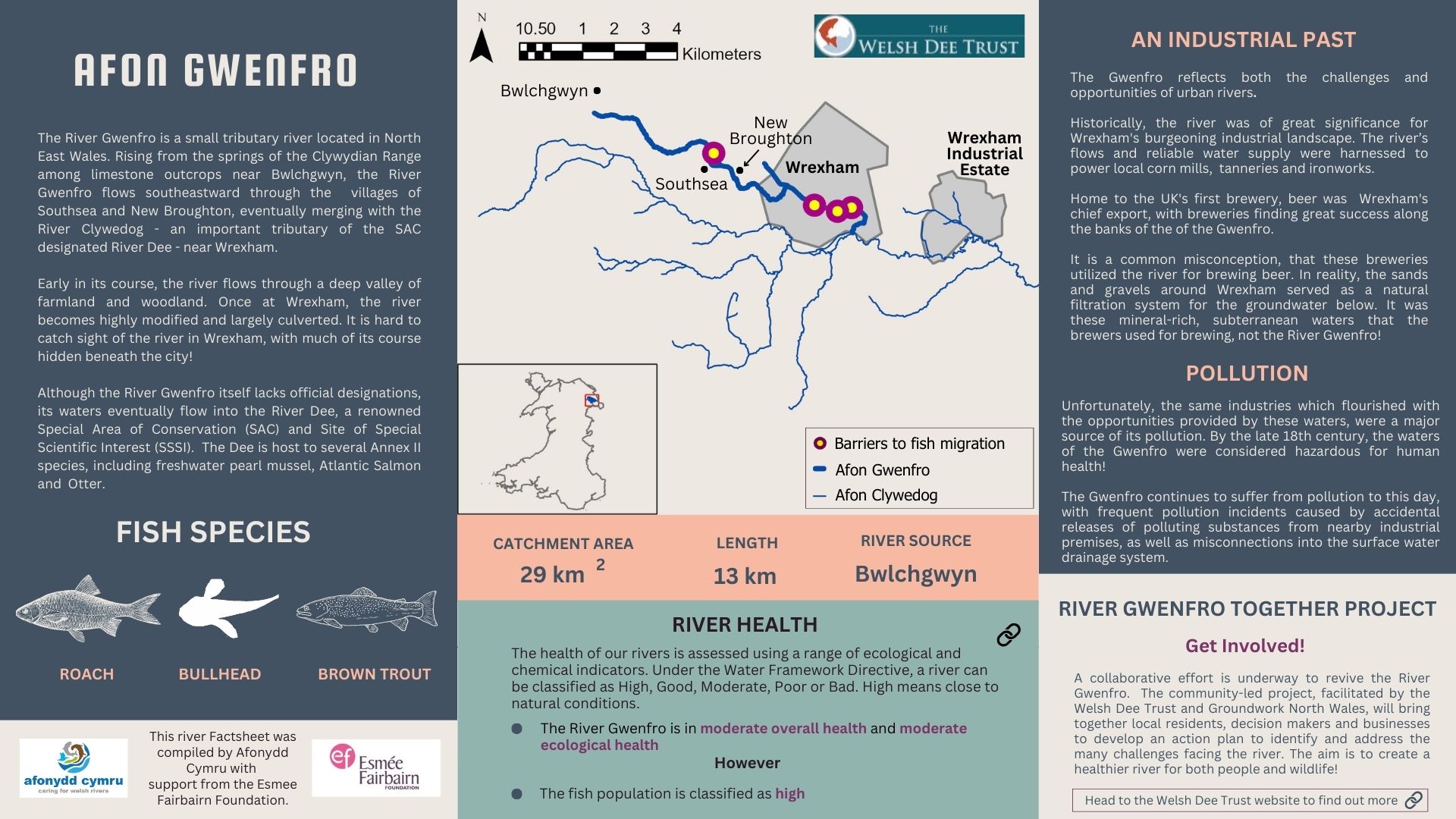May 2024
Awarded city status in 2022, Wrexham in North Wales is known for many things: Wales’s fourth largest city; the first place in the UK to brew lager; an age-old argument over whether its name is Welsh or English and as host to one of oldest football clubs in Britain, now soaring up the divisions on the back of Hollywood stardom.
Integral to its history but less well-known is the small river that runs through the city. The Afon Gwenfro starts life several miles to the west, flowing for around 10km through unspoiled farm and woodland before arriving in Wrexham and joining the Afon Clywedog, itself a tributary of the Dee. Known as the “Gwenny” locally, its full name “Gwenfro” is believed to derive from the Welsh term for “holy vale.”
Downloadable Gwenfro factsheet

The upper Gwenfro flows through a rural landscape (above) before it arrives at Wrexham (below) and becomes a truly urban river.


Phosphate testing on the cleanwater outfall where it drains into the Gwenfro.
Ode to the Gwenfro
A poem by P.F. Loftus, New Jersey, United States in 1892 about growing up near to the stream
Flow on, flow on thou rippling brook,
Flow past each cornered cranny nook,
‘Neath railway arch and narrowed crook,
And tall oak moaning,
For oft have I thy dewdrops shook,
My nudeness owning.
0, Gwenfro thou has known my early days,
Bright innocence and virtues ways,
‘Ere I began to own these grays,
My temples crowning,
Loved happy stream, I sing thy praise,
And fields a browning.
Could I again review the scene,
Thy hillocked banks so fresh and green,
Where lambkins sport and lovers lean,
In noon sun basking,
Blest would I be both morn and e’en,
Though sad the asking.
Yet, still, mayhap some happier day,
I’ll careless roam thy summer’s way.
When fresh cut clover, perfumed hay,
Is near the barning,
To trace thy pebbly bed and say,
“Old friend, good morning.”
The old church towering high in pride,
The bridged channel low beside,
The market place, the street full wide,
Above the crowning.
Its busy life and manful tide
Thy music drowning.
Now gentle stream I’ll say good bye!
Though three thousand miles between us lie,
In spirit I see thee running high
To swell the ocean,
And flowing onward still decry,
Life’s commotion.
Industrial Era Pollution
In common with most rivers flowing through urban areas that expanded during the industrial era, the Gwenfro has suffered its fair share of mistreatment in the last two hundred years. By the late 18th century, its water was considered hazardous for human health and was a vector for some of the more dangerous waterborne diseases prevalent at the time. In August 1878, following the latest outbreak of diphtheria, the Wrexham Advertiser reported on the council’s plans to protect local residents:
“In order to prevent all risk of water being drunk from the Gwenfro Brook, and to abate all nuisance arising from it, it is desirable that the brook should be covered over.”
The council also demanded efforts be made to prevent the sewage pollution that was known to be exacerbating health problems. In October that year, Hugh Davies, the council’s sanitary inspector, had the unenviable job of surveying the brooks in and around Wrexham.
He found that: “”¦..the water comes down nearly as ‘black as ink,’ accompanied with ‘insufferable stench,’ and that at these times all the fish in the brook were destroyed.” And that: “The inhabitants of King’s Mills (where the Gwenfro joins the Clywedog), 71 in number, cried aloud against the stench arising from the brook, particularly those near it, who state that the effluvia is so bad at times that they cannot eat or sleep, and they believe their health is affected by it.”
One month later, a Parliamentary Notice declared that the Gwenfro was to be culverted in Wrexham. The work was completed in 1881 and to this day, the river is largely hidden as it passes through the city. Yet it seems this drastic action was not entirely successful in its mission. In November 1893, the sanitary inspector reported that the Gwenfro still “”¦..was greatly polluted, and the stench arising from it on several occasions was most offensive.”
Raw sewage was not the only source of the pollution. Mining was also having a detrimental effect on the stream’s water quality, especially the nearby Broughton and Plaspower colliery, as was the local gas and leather works.
Another source was more unusual. In the very same year the Gwenfro was culverted, two German immigrants living in Wrexham who had not acquired a taste for the local beer began the first production of lager in the UK. Three years later in 1884, it was reported that the river’s eels had become unusually easy to catch by local children. Discharges of warm water from the lager brewery were the prime suspect but the reactions of the fish could also have been affected by any alcohol leaking into the river, perhaps more so than the eel-catching skills of the children.
Nowadays, while nowhere as bad as in the Victorian era, the Gwenfro still suffers from water quality issues, mainly caused by the water company discharges, road runoff, other industry and legacy mines. Fly-tipping and invasive species also add to the degraded habitat caused by the urban modifications to the river in Wrexham.
Never a lost cause for local people
A common theme in this River of the Month series is that however polluted a Welsh river has become, there remains a deep-rooted affection for it ingrained within people who live or grew up nearby, whatever the time period. And alongside this is quite often an equally powerful determination to see an affected river return to good health.
The Gwenfro is no different. At a time when it was being hidden away in culverts, local newspapers were publishing memories of an untouched river, along with wishes for a return to those better times. A letter to the Wrexham Advertiser in 1881 expressed the hope that “”¦.if Mr Hugh Davies can stop the poisonous nuisances that kill the fish, the Gwenfro may yet become famous for trout.”
Those strong local connections remain today. The river is protected by community volunteer groups such as the Wrexham Litter Pickers who do an admirable job, frequently clearing rubbish from the stream within the city. In one clearance earlier this month, they removed 18 bags of litter, along with 6 shopping trollies, cabling, a paddling pool, soiled clothing, bikes, scooters and a play house in just one morning’s work.
Effective citizen science
Through their “It Shouldn’t Be In The Dee” project, Welsh Dee Trust are also enabling local people to make a difference by helping to track down and identify sources of pollution. In one recent instance, volunteers trained by the trust took water samples from where a drain enters the Gwenfro in Wrexham, finding it to be contributing very high levels of phosphate.
After further investigation by the trust, Wrexham Council, Welsh Water and Natural Resources Wales, it was found that misconnections were almost certainly to blame for the readings. The council have begun the process of finding these and have already warned a business who were found disposing cleaning products into a road drain, completely unaware that it was connected directly to the river via this outfall.
More awareness-raising visits will be undertaken by the council and Natural Resources Wales, while the Welsh Dee Trust will be marking all the clean water drains in the area that are connected to the Gwenfro. Meanwhile, the citizen scientists will be ready at the outfall to monitor the rate of success.
River Gwenfro Together
And finally, with funding from the Esmee Fairbairn Foundation, Welsh Dee Trust and Groundwork North Wales have launched their “River Gwenfro Together” Project. This community-led initiative will enable local residents, businesses, schools and groups to all play a part in formulating and delivering a plan to restore the river and protect local communities from flooding.
The Gwenfro will never be a river entirely untouched by human influence but a vital asset for its future health (and that of other rivers in Wales) is the fondness local people have always held for it, even by those who have long moved away.

An engraving from 1817 showing the Gwenfro flowing through the middle of Wrexham before it was culverted.
Our thanks to Peter Powell and Holly Jenkinson from Welsh Dee Trust for information and photography.
References & More Information:
River Gwenfro Together Project
Launching the River Gwenfro Together Project!
Wrexham Litter Pickers (Facebook page)

